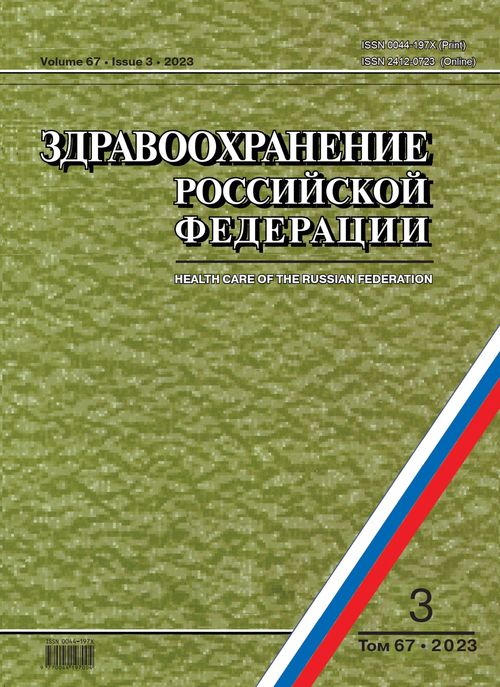Premature mortality from tuberculosis and HIV infection in Russia before and during the COVID-19 pandemic
- 作者: Tsybikova E.B.1, Vladimirov A.V.2
-
隶属关系:
- Russian Research Institute of Health
- Research Institute for Healthcare Organization and Medical Management of Moscow Healthcare Department
- 期: 卷 67, 编号 3 (2023)
- 页面: 230-236
- 栏目: PROBLEMS OF SOCIALLY SIGNIFICANT DISEASES
- ##submission.dateSubmitted##: 25.10.2024
- URL: https://rjonco.com/0044-197X/article/view/638062
- DOI: https://doi.org/10.47470/0044-197X-2023-67-3-230-236
- EDN: https://elibrary.ru/jiqfdl
- ID: 638062
如何引用文章
全文:
详细
Introduction. The introduction of restrictive measures during the COVID-19 pandemic led to a reduction in the timing of screening aimed at early detection of tuberculosis among the population. As a result, there has been increased the proportion of patients with common forms of tuberculosis, the treatment of which is of considerable complexity and creates a high risk of death.
Objective of research: study of premature mortality from tuberculosis and HIV infection in Russia before and during the Covid-19 pandemic.
Material and methods. Rosstat data on deaths due to tuberculosis and HIV infection over 2000–2020. The age of 70 years has been adopted as the standard age for calculating the indicator of has increased potential years of life lost (PYLL). Pearson and Spearman correlation coefficients were used for the analysis.
Results: In Russia, before the Covid-19 pandemic in 2000–2019, the decrease in the total number of patients who died from tuberculosis and HIV infection, and the total PYLL, occurred due to a decrease in the proportion of patients who died from tuberculosis — from 99.3% to 25.4%. Pandemics in 2020 in addition, total PYLL decreased to 45.3% or by 9%, PYLL from TB to 8.9% or by 10.1%, PYLL from HIV infections to 36.4% or by 8.9% compared to 2019.
Limitations of the study. The analysis of PYLL from tuberculosis and HIV infection was carried out for the entire population and for individual age groups in 2000–2020, which was sufficient to achieve the goal.
Conclusion. In Russia, during the pandemic, the main reason for the decrease in the total PYLL and PYLL from tuberculosis and HIV infection were changes in the definition of the main cause of death in the combination of tuberculosis and HIV infection with Covid-19, when Covid-19 began to be indicated as such, and tuberculosis and HIV infection moved into the category of secondary causes and ceased to take part in the formation of mortality rates from these diseases.
Compliance with ethical standards. This study did not require the submission of the conclusion of the Biomedical ethics committee or other documents.
Contribution of the authors:
Tsybikova E.B. — concept and design of the study;
Vladimirov A.V. — processing of the material.
All co-authors are collecting material, writing and editing text.
Acknowledgment. The study had no sponsorship.
Conflict of interest. The authors declare no conflict of interest.
Received: July 07, 2022
Accepted: September 08, 2022
Published: July 06, 2023
作者简介
Erzheny Tsybikova
Russian Research Institute of Health
编辑信件的主要联系方式.
Email: erzheny2014@yandex.ru
ORCID iD: 0000-0002-9131-3584
MD, PhD, DSc, Russian Research Institute of Health, Moscow, 127254, Russian Federation.
e-mail: erzheny2014@yandex.ru
俄罗斯联邦Alexander Vladimirov
Research Institute for Healthcare Organization and Medical Management of Moscow Healthcare Department
Email: noemail@neicon.ru
ORCID iD: 0000-0003-1534-3295
俄罗斯联邦
参考
- European Centre for Disease Prevention and Control, WHO Regional Office for Europe. Tuberculosis surveillance and monitoring in Europe 2021–2019 date. Available at: https://apps.who.int/iris/bitstream/handle/10665/340210/9789289056656-eng.pdf
- UNAIDS. Strategic Information Hub for Eastern Europe and Central Asia. Available at: http://eecahub.unaids.org
- Dheda K., Perumal T., Moultrie H., Perumal R., Esmail A., Scott A.J., et al. The intersecting pandemics of tuberculosis and COVID-19: population-level and patient-level impact, presentation, and corrective interventions. Lancet Respir. Med. 2022; 10(6): 603–22. https://doi.org/10.1016/S2213-2600(22)00092-3
- The Union. The union statement on who global tb report 2021. Available at: https://theunion.org/news/the-union-statement-on-who-global-tb-report-2021
- Glaziou P. Predicted impact of the COVID-19 pandemic on global tuberculosis deaths in 2020. medRxiv. 2020. Preprint. https://doi.org/10.1101/2020.04.28.20079582
- Zimmer A., Klinton J., Omenka C., Heitkamp P., Nawina Nyirenda C., Furin J., et al. Tuberculosis in times of COVID-19. J. Epidemiol. Community Health. 2022; 76(3): 310–6. https://doi.org/10.1136/jech-2021-217529
- Motta I., Centis R., D’Ambrosio L., García-García J.M., Goletti D., Gualano G., et al. Tuberculosis, COVID-19 and migrants: preliminary analysis of deaths occurring in 69 patients from two cohorts. Pulmonology. 2020; 26(4): 233–40. https://doi.org/10.1016/j.pulmoe.2020.05.002
- McQuaid C.F., Vassall A., Cohen T., Fiekert K., White R.G. The impact of COVID-19 on TB: a review of the data. Int. J Tuberc. Lung Dis. 2021; 25(6): 436–46. https://doi.org/10.5588/ijtld.21.0148
- Fuady A., Houweling T.A.J., Richardus J.H. COVID-19 and tuberculosis-related catastrophic costs. Am. J. Trop. Med. Hyg. 2020; 104(2): 436–40. https://doi.org/10.4269/ajtmh.20-1125
- Ravil’one M.K., Korobitsyn A.A. End TB – the new who strategy in the SDG era* , and the contributions from the Russian Federation. Tuberkulez i bolezni legkikh. 2016; 94(11): 7–15. https://elibrary.ru/xelmzt (in Russian)
- Vladimirov A.V., Tsybikova E.B. Premature mortality from HIV-infection and tuberculosis. Sotsial’nye aspekty zdorov’ya naseleniya. 2018; (6): 11. https://doi.org/10.21045/2071-5021-2018-64-6-11 https://elibrary.ru/prlzby (in Russian)
- Ivanova A.E., Kondrakova E.V. Grounds for life expectancy projections in Russian regions up to 2025. Sotsial’nye aspekty zdorov’ya naseleniya. 2008; (1): 8. https://elibrary.ru/jvwsnb (in Russian)
- Krasil’nikov I.A., Ivanova A.E., Semenova V.G., Sabgayda T.P., Evdokushkina G.N. The lost years of potential life (PGPJ) to substantiate priority health problems of the Russian population at the federal, regional and municipal levels: Methodological recommendations. Moscow; 2014. (in Russian)
- Rutstein D.D., Berenberger W., Chalmers T.C., Child G.C., Fischmen A.P., Perrin E.B. Measuring the quality of medical care. A clinical method. N. Engl. J. Med. 1976; 294(11): 582–8. https://doi.org/10.1056/nejm197603112941104
- Charlton J.R.H., Velez R. Some international comparisons of mortality amenable to medical intervention. Br. Med. J. (Clin. Res. Ed.) 1986; 292(6516): 295–301. https://doi.org/10.1136/bmj.292.6516.295
- Ryazantsev S.V., Ivanova A.E., Grishin A.S. Assessment methodology preventable mortality of the population: the territorial and historical approaches. Nauchnoe obozrenie. Seriya 1: Ekonomika i pravo. 2013; (6): 69–76. https://elibrary.ru/ruxtyl (in Russian)
- Tsybikova E.B. On the causes of death of for the first time identified patients with lung tuberculosis. Zdravookhranenie Rossiyskoy Federatsii. 2013; 57(1): 15–9. https://elibrary.ru/pvebgr (in Russian)
补充文件








